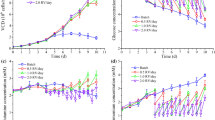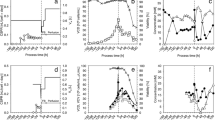Abstract
Sabin–IPV (or sIPV, inactivated polio vaccine based on attenuated Sabin strains) is anticipated to replace the oral polio vaccine for the endgame in polio eradication. Optimization of sIPV production will lead to a better economically feasible vaccine. To assist process optimization, we studied Sabin type 1 poliovirus (PV) infection kinetics on Vero cells in controlled bioreactor vessels. The aim of our study was to develop a descriptive mathematical model able to capture the dynamics of adherent Vero cell growth and PV infection kinetics in animal component free medium. The model predicts the cell density, metabolites profiles, and viral yields in time. We found that the multiplicity of infection (MOI) and the time of infection (TOI) within the investigated range did not affect maximal PV yields, but they did affect the process time. The latter may be reduced by selecting a low TOI and a high MOI. Additionally, we present a correlation between viral titers and D-antigen, a measure for immunogenicity, of Sabin type 1 PV. The developed model is adequate for further studies of the cell metabolism and infection kinetics and may be used to identify control strategies to increase viral productivity. Increased viral yields reduce costs of polio vaccines with large implications on public health.





Similar content being viewed by others
References
Petiot E, Guedon E, Blanchard F, Geny C, Pinton H, Marc A (2010) Kinetic characterization of Vero cell metabolism in a serum-free batch culture process. Biotechnol Bioeng 107(1):143–153
Quesney S, Marc A, Gerdil C, Gimenez C, Marvel J, Richard Y, Meignier B (2003) Kinetics and metabolic specificities of Vero cells in bioreactor cultures with serum-free medium. Cytotechnology 42(1):1–11
Friesewinkel P, Niu H, Drugmand JC, Bogaerts P (2010) Simple metabolic modelling of Vero cell growth on glucose. Paper presented at the 11th International symmposium on computer applications in biotechnology, Leuven, Belgium
Mendonça RZ, Arrózio SJ, Antoniazzi MM, Ferreira JMC, Pereira CA (2002) Metabolic active-high density VERO cell cultures on microcarriers following apoptosis prevention by galactose/glutamine feeding. J Biotechnol 97(1):13–22
Philips BR, Aunins JG, Laska ME, Otero JM (2011) Chemical engineering perspectives on vaccine production. http://www.aiche.org/publications/cep/2011/november/chemical-engineering-perspectives-vaccine-production [accessed 01.10.2013]
Duchene M, Peetermans J, D’Hondt E, Harford N, Fabry L, Stephenne J (1990) Production of poliovirus vaccines: past, present, and future. Viral Immunol 3(4):243–272
Koch F, Koch G (1985) The molecular biology of poliovirus. Springer, Wien
Schulze-Horsel J, Schulze M, Agalaridis G, Genzel Y, Reichl U (2009) Infection dynamics and virus-induced apoptosis in cell culture-based influenza vaccine production-Flow cytometry and mathematical modeling. Vaccine 27(20):2712–2722
Licari P, Bailey JE (1992) Modeling the population dynamics of baculovirus-infected insect cells: optimizing infection strategies for enhanced recombinant protein yields. Biotechnol Bioeng 39(4):432–441
Maranga L, Brazao TF, Carrondo JT (2003) Virus-like particle production at low multiplicitis of infection with the baculovirus insect cell system. Biotechnol Bioeng 84(2):245–253
Mohler L, Flockerzi D, Sann H, Reichl U (2005) Mathematical model of influenza A virus production in large-scale microcarrier culture. Biotechnol Bioeng 90(1):46–58
Nielsen LK (2000) Virus production from cell culture, kinetics. The encyclopedia of cell technology. Wiley, New York
Power JF, Reid S, Radford KM, Greenfield PF, Nielsen LK (1994) Modeling and optimization of the baculovirus expression vector system in batch suspension culture. Biotechnol Bioeng 44(6):710–719
Wong KT, Peter CH, Greenfield PF, Reid S, Nielsen LK (1996) Low multiplicity infection of insect cells with a recombinant baculovirus: the cell yield concept. Biotechnol Bioeng 49(6):659–666
Heinsbroek E, Ruitenberg EJ (2010) The global introduction of inactivated polio vaccine can circumvent the oral polio vaccine paradox. Vaccine 28(22):3778–3783
Thomassen YE, van der Welle JE, van Eikenhorst G, van der Pol LA, Bakker WAM (2012) Transfer of an adherent Vero cell culture method between two different rocking motion type bioreactors with respect to cell growth and metabolic rates. Process Biochem 47(2):288–296
Bakker WAM, Thomassen YE, van’t Oever AG, Westdijk J, van Oijen MGCT, Sundermann LC, van’t Veld P, Sleeman E, van Nimwegen FW, Hamidi A, Kersten GFA, van den Heuvel N, Hendriks JT, van der Pol LA (2011) Inactivated polio vaccine development for technology transfer using attenuated Sabin poliovirus strains to shift from Salk-IPV to Sabin-IPV. Vaccine 29(41):7188–7196
Thomassen YE, van’t Oever AG, Vinke M, Spiekstra A, Wijffels RH, van der Pol LA, Bakker WA (2012) Scale-down of the inactivated polio vaccine production process. Biotechnol Bioeng 110(5):1354–1365
ten Have R, Thomassen YE, Hamzink MR, Bakker WA, Nijst OE, Kersten G, Zomer G (2012) Development of a fast ELISA for quantifying polio D-antigen in in-process samples. Biologicals 40(1):84–87
Thomassen YE, Rubingh O, Wijffels RH, van der Pol LA, Bakker WA (2014) Improved poliovirus D-antigen yields by application of different Vero cell cultivation methods. Vaccine 32(24):2782–2788
Baty F, Delignette-Muller M (2004) Estimating the bacterial lag time: which model, which precision? Int J Food Microbiol 91(3):261–277
Mohler L, Bock A, Reichl U (2008) Segregated mathematical model for growth of anchorage-dependent MDCK cells in microcarrier culture. Biotechnology Prog 24(1):110–119
Kiparissides A, Koutinas M, Pistikopoulos EN, Mantalaris A (2010) Model Development and Analysis of Mammalian Cell Culture Systems. In: Process Systems Engineering. Wiley-VCH Verlag GmbH & Co. KGaA, pp 403–439
Hassell T, Gleave S, Butler M (1991) Growth inhibition in animal cell culture. The effect of lactate and ammonia. Appl Biochem. Biotechnology 30(1):29–41
Sakagami H, Satoh M, Yokote Y, Takano H, Takahama M, Kochi M, Akahane K (1998) Amino acid utilization during cell growth and apoptosis induction. Anticancer Res 18(6A):4303–4306
Kovarova-Kovar K, Egli T (1998) Growth kinetics of suspended microbial cells: from single-substrate-controlled growth to mixed-substrate kinetics. Microbiol Mol Biol Rev 62(3):646–666
Heijnen JJ, Verheijen PJ (2013) Parameter identification of in vivo kinetic models: limitations and challenges. Biotechnol J 8(7):768–775
Thomassen YE, van’t Oever AG, van Oijen MG, Wijffels RH, van der Pol LA, Bakker WA (2013) Next generation inactivated polio vaccine manufacturing to support post polio-eradication biosafety goals. PloS One 8(12):e83374
WHO (2012) Recommendations to assure the quality, safety and efficacy of live attenuated poliomyelitis vaccine (oral). Replacement of TRS 904, annex 1 and addendum TRS 910, annex 1
Quesney S, Marvel J, Marc A, Gerdil C, Meignier B (2000) Characterization of Vero cell growth and death in bioreactor with serum-containing and serum-free media. Cytotechnology 35:115–125
Acknowledgments
The authors would like to thank Bella Monica for assistance in performing bioreactor experiments, Dionne David for performing the virus analysis and Alex de Haan for amino acid analysis.
Author information
Authors and Affiliations
Corresponding author
Rights and permissions
About this article
Cite this article
Ursache, R.V., Thomassen, Y.E., van Eikenhorst, G. et al. Mathematical model of adherent Vero cell growth and poliovirus production in animal component free medium. Bioprocess Biosyst Eng 38, 543–555 (2015). https://doi.org/10.1007/s00449-014-1294-2
Received:
Accepted:
Published:
Issue Date:
DOI: https://doi.org/10.1007/s00449-014-1294-2




